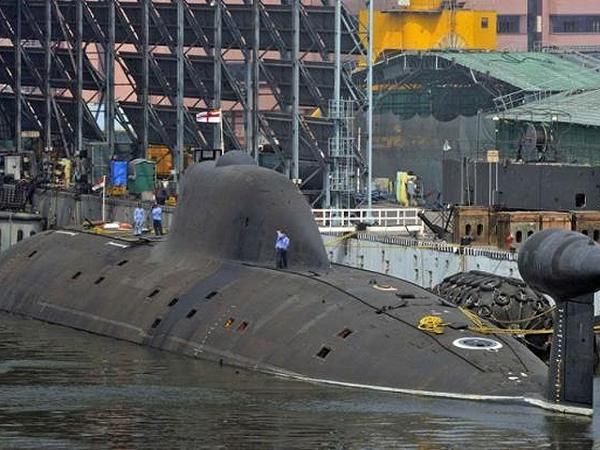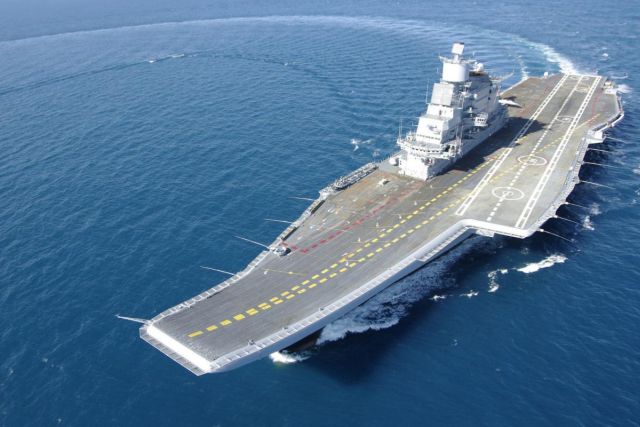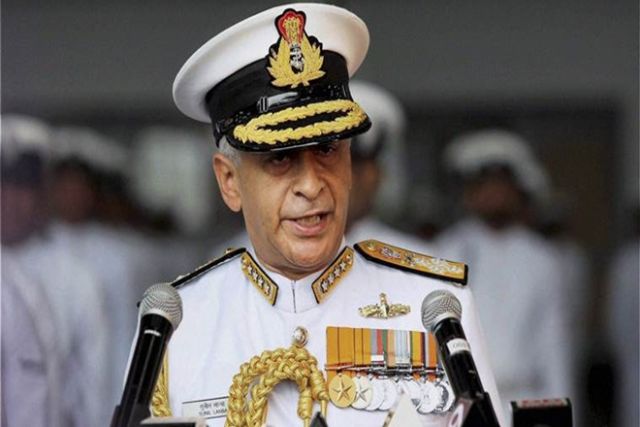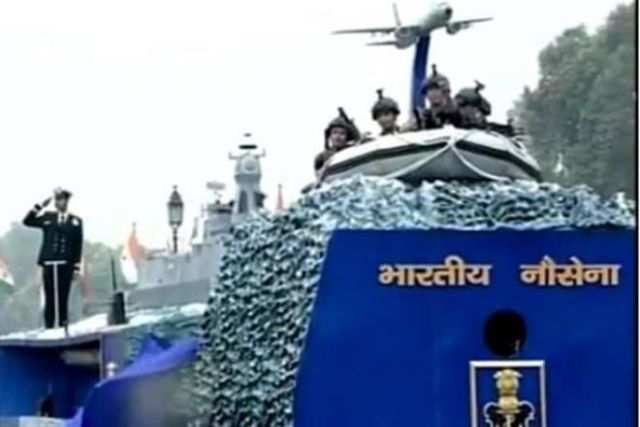
by admin | May 25, 2021 | Business, Corporate, Corporate Governance, Large Enterprise, News
 By Shantanu Guha Ray,
By Shantanu Guha Ray,
New Delhi : The Indian Navy’s reported decision to nominate Mazagon Dock Shipbuilders Ltd (MDL) to execute the $8 billion Project-75 India [P-75(I)] to build six advanced submarines has left private contenders gasping for breath.
The P-75(I) programme was once the biggest rays of hope for the private sector, especially companies like Larsen & Tubro and Reliance Naval that were gearing up for orders under the programme announced in October 2014. The private shipyards — L&T’s at Kattupalli and Reliance Naval’s at Pipavav — currently have turnovers of under Rs 1,000 crore and have slipped into the red.
The private sector in India has less than 5 per cent (about Rs 5,000 crore annually) share of direct orders from the Defence Ministry for manufacturing. “The expectation was that the private sector’s share will rise to almost 25 percent in the next three-four years,” Vice Admiral (Retd) Shekhar Sinha told BTVI.
Sinha said the private players should be integrated into the country’s defence manufacturing sector that was liberalised way back in 2001 and opened up participation to not just private players but also to foreign entities. “Make in India is impossible without the participation of the private sector,” said Sinha.
Last May, India cleared a long-awaited policy to push local defence manufacturing by effectively picking industry champions that would tie up with foreign players to make submarines, fighter jets, helicopters and armoured vehicles. The decision came after Prime Minister Narendra Modi vowed to end India’s role as the world’s largest arms importer by asking foreign firms to share technology with local players and then manufacture in India — in return for a slice of the $250 billion analysts claim the country would spend on its armed forces over the next decade.
The government, under the “Strategic Partnership” model, would shortlist and then pick Indian companies to join forces with foreign firms. The winners were guaranteed billions of dollars of orders to incentivise them to manufacture. “For each platform, one private sector strategic partner will be chosen,” then Defence Minister Arun Jaitley had told reporters after a cabinet meeting at that time. “You don’t set up a manufacturing facility if you don’t have any hope of getting orders.”
The Defence Ministry had thereafter drafted its out-of-the-box Strategic Partnership model by building on recommendations of several expert committees and groups. And private players were an integral part of the plan. “Everyone hoped the P75(I) project will come to the private players but it seems that the plan is now shelved,” added Sinha.
Former navy chief Admiral Vishnu Bhagwat said it was imperative for the government to include private players in defence manufacturing. “I am shocked at the decision. During my tenure I had drawn up a 30-year plan and given it to (the then) Defence Minister. In India, very sadly, the Ministry of Defence and its procurement team hardly understand their business,” Bhagwar told BTVI.
Agreed strategic expert C. Uday Bhaskar, who felt the decision would prove “disastrous” for the country in the long run. “India knows the public sector has not delivered in the defence sector and in the shipbuilding sector, where foreign participation is a must. The private sector was encouraged to get into this sector; many acquired and developed infrastructure so that they can be considered relevant for business from the government. And now we hear that the decision has gone — again — to a PSU known for its delays,” Bhaskar told BTVI.
Defence manufacturing in India is small and dominated by PSUs, many of which have been criticised for poor performance. Private firms such as Larsen & Toubro, Mahindra Group, Tata Group and recent entrants Reliance Group and Adani Group are trying hard to seek orders. One of the aims of involving private players was to create submarine-building capabilities outside of the state-owned shipyards that were known for cost and time over-runs.
In 2016, the Indian Navy issued a Request for Information (RFI) to six global submarine makers seeking to build six advanced submarines with air-independent propulsion (AIP) technology that enables them stay under water for longer periods. The six companies were ThyssenKrupp Marine Systems (Germany), Naval Group (France), Navantia (Spain), SAAB (Sweden), Rubin Design Bureau-Amur Shipyard (Russia and Italy) and Mitsubishi Heavy Industries and Kawasaki Heavy Industries (Japan). This was around October 2017, when Jaitley headed the Defence Ministry.
The Defence Ministry then drafted Expressions of Interest (EoI) to be issued to the private sector shipyards in India so as to select the local Strategic Partners. But in less than a year’s time, new Defence Minister Nirmala Sitharaman has decided to dump that process. Officials of Indian Navy did not explain reasons for reversing the original plan, first mooted by Manohar Parrikar when he was the Defence Minister.
At a meeting chaired by the Sitharaman in late March, it was decided that the P75(I) programme would not be rolled out under the Strategic Partnership Policy of the Defence Procurement Procedure 2016, as initially decided, and would be handed over to MDL on a “nomination basis”.
The decision, taken less than a month after the visit to India by President Emmanuel Macron, is being viewed as a positive one for the French shipbuilding conglomerate Naval Group, which already has a collaboration with MDL under which it is currently building six Scorpene Class submarines. The first of these has been launched and the rest are to be commissioned by 2020.
(Shantanu Guha Ray is with Business Television India, BTVI. Views expressed are his own. He can be contacted at shantanu.ray@btvi.in.)
—IANS

by admin | May 25, 2021 | Corporate, Corporate Governance, Corporate Jobs, Employment, Private Jobs
 New Delhi : Online recruitment service provider Monster India on Friday said it has signed a MoU with the Indian Navy Placement Agency to provide retired and shortly retiring navy personnel with alternate career opportunities in the corporate sector.
New Delhi : Online recruitment service provider Monster India on Friday said it has signed a MoU with the Indian Navy Placement Agency to provide retired and shortly retiring navy personnel with alternate career opportunities in the corporate sector.
“Monster India aims to list more than 1,000 opportunities in the next 12 months (on monsterindia.com) with a target of increasing this number to 2,000 opportunities by the year 2020,” it said in a statement.
The focus would be on identifying opportunities in sectors such as capital goods industries, information technology (IT), and IT-enabled services, security space, micro, small and medium enterprises and so on, the statement said.
Abhijeet Mukherjee, CEO, monster.com (APAC and Middle East) said, “We aim to assist retired navy veterans with customised job opportunities in accordance with their skill set. Moreover, Monster India will regularly provide the candidates with job fairs, interview etiquette tips, career recommendations.”
—IANS

by admin | May 25, 2021 | News, Politics

INS Vikramaditya
New Delhi : Indian Naval Ship Vikramaditya, the Indian Navy’s largest ship and its sole aircraft carrier was formally affiliated to the Indian Army’s highly-decorated and battle-hardened Bihar Regiment and the Indian Air Force’s No. 6 Squadron, that is tasked with maritime strike operations with its Jaguar fighter aircraft.
A glittering ceremony was held onboard INS Vikramaditya at the Karwar Naval Base, nestled amongst the picturesque Western Ghats, attended by Western Naval Command chief Vice Admiral Girish Luthra, and the Army’s Military Secretary Lt General Amarjeet Singh, who is also the Colonel of the Bihar Regiment.
Air Officer Commanding Maritime Air Operations, Air Vice Marshal M. Fernandez was the senior officer from the IAF at the event also saw participation by a host of senior officers from all the three services.
The historic affiliation ceremony commenced with an inspection of the Tri-Service Guard of Honour by the senior officers.
Addressing the gathering, Western Fleet commander, Rear Admiral R.B. Pandit said the idea behind the affiliation was to foster espirit de corps and friendship between the three units that would lead to greater synergy and jointmanship between them and also promote interaction between the personnel and their families.
The formal association between the three units commenced with the reading of the ‘Charter of Affiliation’ which listed its aims and the association that the units were to maintain. The charter was subsequently signed by the commanding officers of the three units and by senior officers from respective services.
This was followed by an exchange of mementoes between the three units.
The event also was an impressive flypast by aircraft of the Fleet Air Arm, led by a formation of Chetak helicopters followed by formation of MiG-29K fighters of the Indian Navy’s 303 Squadron from the Goa-based Naval Air Station, INS Hansa.
“The ‘raison d’etre’ of affiliation between units of fighting forces is to act as a force multiplier by promoting better understanding of each other’s strengths and ultimately serves to maximise the combat potential of the Indian Armed Forces at the time of reckoning. It also fosters a deep understanding of each other’s service ethos, customs, traditions and sharing of new operational concepts and the same is aptly described in the affiliation motto aVictory through Jointness’,” an official statement said.
The affiliation involved a host of activities over January 17 and 18, including a formal dinner, affiliation ceremony and organized visits for the visiting personnel. The event culminated with a grand ‘Barakhana’, a ceremonial dinner which is attended by all ranks together, organised onboard INS Vikramaditya for all the participating personnel.
—IANS

by admin | May 25, 2021 | Corporate, Corporate Governance, Interviews

Admiral Sunil Lanba
By Gulshan Luthra,
New Delhi : The Indian Navy is considering the acquisition of more Boeing P-8I aircraft for surveillance and Anti-Submarine Warfare (ASW), according to Navy chief Admiral Sunil Lanba.
In an interview to the magazine ‘India Strategic’, Admiral Lanba said that air surveillance capability is an important subset of naval operations and that while the proposal was on the table, he could not disclose the required numbers.
His predecessors have spoken of a requirement of 30 Long-Range Maritime Reconnaissance (LRMR) aircraft, under which the navy has already inducted eight aircraft and placed an order for four more.
Because of the overall tardy process of routine modernisation of the armed forces over the last 30 years, the Indian Navy has not been able to renew its inventory of submarines but the acquisition of the P-8I (I stands for India) has given it a very strong offensive capability to detect and hunt hostile submarines.
In fact, in terms of contemporary weapon technologies, the P-8I, often referred to as the “submarine killer”, is perhaps the most advanced system that any of the three Indian services have acquired in recent years. The aircraft was deployed in 2013 by the Indian Navy around the same time the US Navy did.
The Defence Ministry has officially stated that the P-8I is “capable of thrusting a punitive response and maintaining a watch over India’s immediate and extended areas of interest”.
Asked about the growing number of hostile submarines in the Indian Ocean, nearer home in fact, Admiral Lanba said: “As a professional military force, we constantly evaluate the maritime security environment in our areas of interest. We lay a lot of stress on Maritime Domain Awareness (MDA). Accordingly, we are fully seized of the presence and likely intentions of all extra-regional forces operating in the Indian Ocean. Our Navy is fully capable and ever ready to meet any challenges that may arise in the maritime domain.”
Significantly, the agreement for the P-8Is was signed on January 1, 2009, within a couple of months of the 26/11 Mumbai terror attacks which exposed the vulnerability of the country’s maritime defences. The attack, in fact, triggered the government to clear quite a few proposals for the armed forces as well as to review what should be done to ensure security of Indian waters, particularly the coastal belts on the country’s eastern and western seaboards.
The Navy is now the nodal agency for coordinating surveillance through satellites and aircraft and a network of police and small boats has also been integrated into the system.
The Navy and the Indian Coast Guard (ICG) also operate a number of HAL-made Dornier 228 aircraft, while some proposals for more LRMR and Medium-Range Maritime Reconnaissance (MRMR) have been on the table for the last few years.
Observed Admiral Lanba: “Every endeavour is being made to collectively ensure that our maritime security, of which coastal security is an important subset, is adequately strengthened.”
“A number of measures have been taken since 26/11 to strengthen maritime, coastal and offshore security by the concerned agencies in the country. These measures broadly include increasing capacity and capabilities of maritime security forces, enhanced surveillance and domain awareness of the maritime zones, increased regulation of maritime activities, streamlining intelligence-sharing between different agencies and strengthening overall maritime governance. There have been significant improvements in the operational response to developing situations at and from the seas,” he added.
At the national level, coordination of coastal security-related activities is being carried out by the National Committee for Strengthening Coastal and Maritime Security (NCSCMS).
The Navy had ordered eight P-8I aircraft in 2009 for $2.1 billion along with a training package. Weapons and torpedoes were extra as needed, and then, under the Options Clause, four more aircraft were ordered in August 2016.
The standard delivery schedule begins within three years of signing a contract and making the first payment. Boeing has said that it delivered the first lot of eight aircraft “on time, on cost” and helped set up their base at the INS Rajali Naval Air Station at Arakkonam in Tamil Nadu.
Boeing had been awarded a three-year contract in June last year for engineering and logistics support for the P-8I fleet. In January 2018, the Navy has been given approximately Rs 2,000 crore (almost $315 million) for a Training Solution along with a 10-year package for comprehensive maintenance service.
The training facility at INS Rajali will be the third of its kind after those in the US and Australia, and will train pilots, observers and ordnance and technical personnel. Spread over 60,000 sq ft, the facility would be completed by 2021.
A Training Simulator to be set up at the Naval Institute of Aeronautical Technology (NIAT), Kochi, for ab-initio training of the technical personnel is part of the package.
Pratyush Kumar, Boeing’s India President and Vice President International, had observed after signing the three-year contract last year: “Our team remains focused on executing our commitments to customers on schedule and cost. With this contract, the Indian Navy can be assured of achieving exceptional operational capability and readiness of the P-8I fleet.”
Boeing’s earlier contract was due to expire in October 2017.
The Indian variant has certain Indian components, including communication software and IFF (Identify Friend or Foe), to align with Indian naval and Air Force aircraft and net-centric systems.
It has 360-degree radar view, thanks to Raytheon’s AN/APY-40 forward looking radar’s 240-degree coverage and the rest from Telefonics aft-looking radar.
Built on the Boeing 737 frame, the P8-I is capable of detecting and destroying hostile submarines deep under the water. It has 11 hard points for carrying Harpoon anti-shipping missiles and depth charges, and five stations in the weapons bay for Raytheon-supplied Mk-54 torpedoes. Two hard points upfront are for Search and Rescue equipment.
There are five operator stations, and windows for outside views. All the systems are integrated with the onboard Mission Computer and Display System for control and data distribution in high speeds with ultra-high resolution. The APY 10 radar is developed keeping in mind not just the land but waters of the vast oceans as well, be it day or night. It is capable of tracking even small vessels in littoral and high seas environments.
The Indian variant also has the Magnetic Anomaly Detector (MAD) which measures minute variations and disturbances in the earth’s magnetic field caused by the underwater movement of steel-encased submarines.
India has already acquired a number of Harpoon Block II missiles for use both by the Navy and IAF, which also conducts maritime patrols.
(Gulshan Luthra is Editor, India Startegic. He can be contacted at gulshan.luthra@indiastrategic.in)
—IANS

by admin | May 25, 2021 | News, Politics
 By Arul Louis,
By Arul Louis,
New York : In an emerging strategic transformation, India is now considering itself as maritime power and building up its navy to meet that challenge after having thought of itself for a long time as a land power, according to a former senior US diplomat who is a leading expert on South Asia.
India increasingly sees its role across the Indian Ocean as a “net provider of regional security”, which is echoed by the US Secretaries of Defence and State when they talk about its role in the region, Alyssa Ayres, a former deputy assistant secretary of state for South Asia, said Wednesday.
“There is a transformation of the way the Indian Navy talks about the seas, from using the seas to securing the seas – this whole idea of New Delhi now playing a role in protecting the freedom of navigation as opposed to just the sealanes that the Indian Navy uses,” she said.
Ayres, who is now a senior fellow with the Council on Foreign Relations and the author of the recently-published “Our Time Has Come: How India is Making Its Place in the World”, was speaking at the Asia Society here on “India 2018” a look at the year ahead.
When thinking about the strategic future there is concern about China’s activities in East and Southeast Asia, she said.
As a result the US and India share an interest in ensuring that the sealanes remain open.
“India like the US is a vocal advocate of freedom of navigation,” she said. “The US and India are both very focused on this issue.”
“What you have seen in the last four-five months is an increasing convergence, where (President Donald) Trump’s administration has picked up what the Indian, the Japanese and the Australian government talk about, a concept of the Indo-Pacific region,” she said.
While the US traditionally spoke of the Asia Pacific region, the Australians, Japanese and Indian leaders had a broader concept of the Indo-Pacific region, Ayres said.
“The US is now using that same term (and) what that does is that it expands the field of reference, it places India in a much more central role,” she said.
“It acknowledges the fact that India is a major defence partner in this larger (Indo-Pacific) region and that the US and India will continue to partner closely.”
The Philippines Permanent Representative to the UN, Teodoro L. Locsin Jr., questioned the basis of an Indo-Pacific concept saying it was “nowhere comparable to Asia-Pacific relationship to western economies”.
“I think the US focus on an Indian military alliance or relationship is really a distraction for the Chinese,” he said. “The Indian Ocean is just too big a neck to choke. So the real problem really remains the straits and the South China Sea.”
“Whatever is raised about the possibility of a Japan, Australia, India military combination to counter the Chinese concern, the usual reaction from the Philippines and the others is resentment,” he said.
“We do not want to get involved in any quarrel with China that involves India.”
“To get connected to India is really asking for trouble from China,” he added.
Ayres said that the defence relations between Washington and New Delhi have grown through the last three US presidencies and Trump is continuing it.
A measure of the closeness can be seen in the joint military exercises they hold, she said.
“India now exercises more with the US than with any other partner and the talking point on the US side is that it exercises more with India than with any other non-NATO partner.”
(Arul Louis can be reached at arul.l@ians.in)
—IANS





